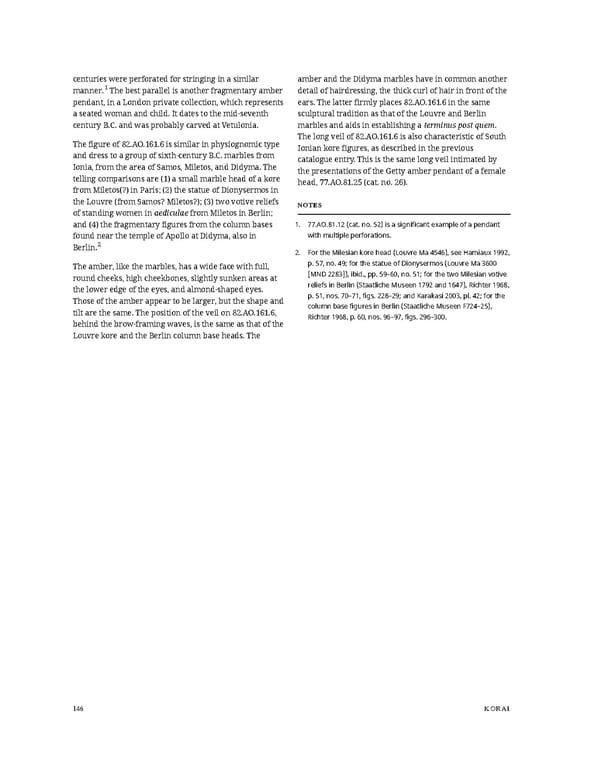centuries were perforated for stringing in a similar amber and the Didyma marbles have in common another manner.1The best parallel is another fragmentary amber detail of hairdressing, the thick curl of hair in front of the pendant, in a London private collection, which represents ears. The latter firmly places 82.AO.161.6 in the same a seated woman and child. It dates to the mid-seventh sculptural tradition as that of the Louvre and Berlin century B.C. and was probably carved at Vetulonia. marbles and aids in establishing a terminus post quem. The long veil of 82.AO.161.6 is also characteristic of South The figure of 82.AO.161.6 is similar in physiognomic type Ionian kore figures, as described in the previous and dress to a group of sixth-century B.C. marbles from catalogue entry. This is the same long veil intimated by Ionia, from the area of Samos, Miletos, and Didyma. The the presentations of the Getty amber pendant of a female telling comparisons are (1) a small marble head of a kore head, 77.AO.81.25 (cat. no. 26). from Miletos(?) in Paris; (2) the statue of Dionysermos in the Louvre (from Samos? Miletos?); (3) two votive reliefs NOTES of standing women in aediculae from Miletos in Berlin; and (4) the fragmentary figures from the column bases 1. 77.AO.81.12 (cat. no. 52) is a significant example of a pendant found near the temple of Apollo at Didyma, also in with multiple perforations. Berlin.2 2. For the Milesian kore head (Louvre Ma 4546), see Hamiaux 1992, The amber, like the marbles, has a wide face with full, p. 57, no. 49; for the statue of Dionysermos (Louvre Ma 3600 round cheeks, high cheekbones, slightly sunken areas at [MND 2283]), ibid., pp. 59–60, no. 51; for the two Milesian votive the lower edge of the eyes, and almond-shaped eyes. reliefs in Berlin (Staatliche Museen 1792 and 1647), Richter 1968, Those of the amber appear to be larger, but the shape and p. 51, nos. 70–71, figs. 228–29; and Karakasi 2003, pl. 42; for the tilt are the same. The position of the veil on 82.AO.161.6, column base figures in Berlin (Staatliche Museen F724–25), behind the brow-framing waves, is the same as that of the Richter 1968, p. 60, nos. 96–97, figs. 296–300. Louvre kore and the Berlin column base heads. The 146 KORAI
 Ancient Carved Ambers in the J. Paul Getty Museum Page 155 Page 157
Ancient Carved Ambers in the J. Paul Getty Museum Page 155 Page 157